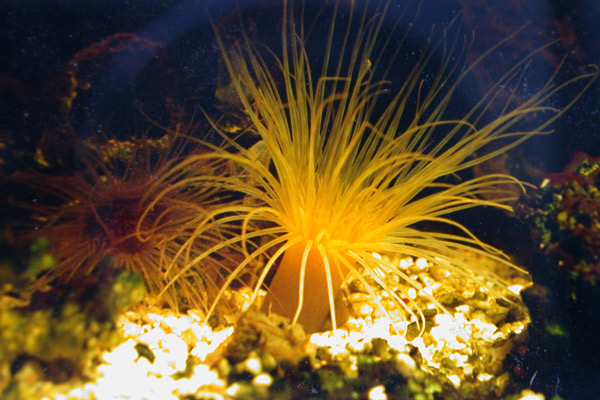Winter sea is stronger
 There is an explosion of life submerged in blue, all around us. While fish and invertebrates gather energy for reproduction, the “green shrimp” of Posidonia begin their amazing journey that will lead them to change sex: from “fathers” will become “wives”. Oddities to be discovered.
There is an explosion of life submerged in blue, all around us. While fish and invertebrates gather energy for reproduction, the “green shrimp” of Posidonia begin their amazing journey that will lead them to change sex: from “fathers” will become “wives”. Oddities to be discovered.
The sea is a “subject” typical of summer. Many, thinking of the sea, image long sunny beaches, boats, swimming, sunscreen, stones, sand, rakes ... and peppered mussels. The sea, as what surrounds us, is considered a commodity, an object, in fact, to be used without restraint, to its fullest potential. The summer sea, however, produces holiday atmosphere and can be lived day and night, without stopping and without waste. The summer sea is like a pig: you do not throw anything away! It is lived by the beach, on the boat, on board the ferry and even at night, at the restaurant, when its gastronomic resources, exploited well beyond sustainable limits, become entertainment facilities.
In winter, in the minds of the inhabitants of the city, the sea disappears! It can rest in peace, waiting for the next summer holiday. Then it becomes obstacle for navigation, threatening danger for its high and powerful waves, unimportant, moist presence.
Yet the winter sea is anything but at rest. In the winter months the sea really live to their full potential, it becomes the subject rather than object. We talk about the Mare Nostrum, the Mediterranean Sea, where the seasonal rhythms affect ecology and physical and chemistry
Oceanography.
The summer sea is stratified, because the high air temperatures produce surface overheating. The hotter water is also less dense and produces a layer well defined. You can sense when, immersing ourselves, we feel that the hot water is indistinguishable from the underlying layers, appearing cold to skin contact. This separation of layers is called “thermocline” and has profound influences on aquatic organisms. The stratification of the water, in fact, produces chemistry and physics separation. The deeper waters are being depleted of oxygen and nutrients, becoming less productive, sometimes even “sick”. No coincidence that the various “pathologies” of the sea that the press offers us every year correspond precisely to the summer months: eutrophication, pollution, mucilage. The sea-segregated inside barriers of temperature, in fact, becomes “poor”.
The sea in winter is stronger and independent. It is easy to understand even watching from the surface. The thermal stratification are broken by hydrodynamism. So oxygen and nutrients can move freely, to be used by all the inhabitants of the planktonic and benthic communities.
Unlike what happens in the subaerial world, when winter is a period of “rest” for natural communities, the winter sea is an explosion of life, as any diver can confirm. The plant populations are less developed, due to the reduced amount of light available, but are accumulating reserves to produce again in spring. The sessile filter feeders (those attached to the sea-bottom), as sea fans, sponges, anemones, are booming, because the increased distribution of organic detritus and animal plankton, which they feed, transforms their days at banquets and on.
The marine plant more important for our coasts, Posidonia oceanica, presents in this period leaves relatively short, because the amount of usable light is reduced and the plant is able to exploit all without having to resort to long laminae. Even epiphytes (algae that cover the leaves) are less abundant, however, that the prairies have a look deep green, very attractive. The plant, in this period, collects solar energy transforming it into starch, which retains in its rhizomes (a sort of stem and roots, which is located under the sand). In spring, those same reserves will be used to produce long leaves more than a meter that will allow exploiting solar radiation in summer.
Fish and invertebrates, at this time, do the same: building up energy for reproduction during the spring or summer. For example, the green shrimp Posidonia, Hippolyte inermis, ended its reproductive period last September, producing an all-male population. These males will grow slowly in winter, and will mate in spring, with individuals of the opposite sex. Strange to say, these female individuals are their own “fathers”, which during winter will have a sex change! We discover that the “fathers” of the previous summer will become their wives, after a long winter of maturation and sex change. It is the oddities of the sea, or at least, those of us seem such.
It is a fact, however, that the sea we know, what produces beautiful summer atmosphere and stimulates the birth of new loves, could not exist without this winter dining, growth, relative independence from human activities. Partial independence, as the sea continues to produce resources essential to the fishing, shipping, scientific research. It is the place where life is born, and continues to reborn in every season.





